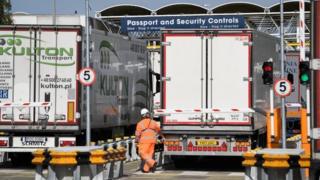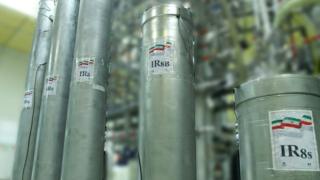 Image copyright
Image copyright
AFP
Huawei says it wants to bring high-speed internet to Canada’s north. But some people are worried this gift from China could be a Trojan Horse.
Want to watch the latest viral hit on YouTube? Transfer money online? Video chat with your grandma?
Don’t hold your breath if you live in Iqaluit, say residents of the city of 7,500, which is located just over 300km (186 miles) from the Arctic Circle.
“It’s still very fragile, a single event can cause a mass outage where people can’t send or receive emails, people can’t get money out of the bank machine, people can’t buy gasoline or groceries at the store,” says the mayor, Madeleine Redfern.
Iqaluit is not the only place waiting to get online.
According to the Canadian government, about 5.4 million people, or 15% of the population, don’t have high-speed internet – and most of them live in the north or in remote, rural areas.
For decades, corporate investment in building digital infrastructure in rural and remote areas has lagged, which means that while the rest of the country has been racing full-force into the digital era, places like Iqaluit have been treading water.
“You can’t stop simply because you’ve met a certain level of service. You have to keep up, otherwise you fall behind,” Redfern says.
Fixing the problem has become a key promise in the Liberal government’s campaign for re-election in October.
The government has promised to bring high-speed internet access to every household by 2031, and last year’s budget pledged a total of C$6bn ($4.5bn, £3.7bn) to help close this connectivity divide, including $1.7bn in new funding.
That puts a bullseye on the north as several companies vie for public funding to build everything from satellites to fibre optic cables.
“There’s a real battle right now about where government investment is going – there’s a lot of money up for grabs,” says Laura Tribe, the executive director for internet advocacy group OpenMedia.
But which projects win out – and who they involve – could shape the future of the internet in Canada for a long time to come.
The struggle for speed
With so much information available at the click of a mouse, it’s easy to forget that the internet is not some ethereal matrix of neon and nanobytes, but an awesome network of cables, warehouses and cell towers.
And like any piece of complex physical infrastructure, building and maintaining the internet isn’t cheap.
In rural and remote areas, like Canada’s arctic, that means that companies or governments must spend a lot of money for a relatively small customer base.
High-speed fibre cables are fewer and farther between, and many communities in the north rely on satellites exclusively to connect, and their coverage is often spotty, slow and expensive.
The Huawei Solution
While some companies may see the north as a headache, others – like Huawei, a digital infrastructure provider with close ties to China’s government – see it as an opportunity.
Huawei Canada announced in July that it will be partnering with local telecommunications companies ICE Wireless and Iristel to expand satellite coverage to 70 communities in the north.
Image copyright
Getty Images
Huawei is one of the largest telecommunications equipment and services providers in the world
The project has been approved by the Communications Security Establishment (CSE), Canada’s cybersecurity authority.
Such a challenge is well within the company’s wheelhouse – currently Huawei is one of the main tech suppliers of 4G wireless in rural America.
“Being the company that provides the backbone is an incredible position of power,” Tribe says. “So it’s not really surprising to see companies recognise the power of providing internet connectivity.”
But the announcement has also raised eyebrows.
Canada has been embroiled in diplomatic tensions with China ever since the arrest of the company’s chief technology officer, Meng Wanzhou, by Canadian authorities at the behest of the US.
Image copyright
Reuters
Ms Meng faces extradition to the US on fraud charges
The US wants the tech executive extradited to stand trial on charges including fraud linked to the alleged violation of sanctions on Iran.
Shortly after her arrest, Chinese authorities arrested two Canadians and accused them of spying.
This has raised concerns that the Arctic could become a pawn in a game of chess between the two nations, especially since they will likely be a monopoly provider in the region, says political scientist Michael Byers, whose research at the University of British Columbia focuses on northern affairs.
“That does create a vulnerability in the event of an escalated Canada-China dispute, where Huawei could potentially be ordered to shut down those services, thus cutting Canadian Arctic communities off the internet,” he told the BBC.
Meanwhile, as the world gets ready for 5G mobile networks, several countries are debating the security implications of Huawei technology.
The US and Australia have banned the company from providing tech to telecoms, while India and the UK are considering a similar decision.
The concern is that the company could use its 5G networks, which can carry a significantly higher volume of data and will pave the way for things like driverless cars and smart cities, to spy on foreign citizens at the request of the Chinese government.
Redfern thinks this is a risk Iqaluit should not have to take alone.
“There’s a tremendous amount of political and trade uncertainty with China at the moment. We need to be careful we’re not putting ourselves, our country and northerners at risk, simply because Canada is not prepared to make the full investment in the northern regions,” she says.
Looking to the sky
Byers believes a solution for the north’s internet woes will come from space, not China.
Floating just 2,000km above the planet, low-Earth orbit satellites provide much faster internet than older-technology satellites, like the one Huawei will use in the north.
Image copyright
Getty Images
There are several satellite broadband projects in development
SpaceX, UK-based startup OneWeb and Amazon are all launching their own low-earth orbit satellites into space in the next few years.
And in July, the Canadian government announced it will invest $85m in a Canadian low-Earth orbit satellite company, Telesat.
But Byers is concerned Huawei’s project in the north could push this new, better technology out before they’ve begun.
“Huawei will come into the same communities with a low-cost, lower-tech version, and Huawei’s going to get there first,” he says.
Bridging the digital divide
Canada is not the only country struggling to bridge the digital divide.
There are unconnected areas in remote parts of Brazil, Mexico and India, and even the UK.
And there are plenty of companies, including Huawei, that are willing to help.
Microsoft, Google, Amazon and Facebook have all also launched projects to connect people in developing countries.
“Getting more people online means getting more users on Google and Facebook products,” says Ramesh Srinivasan, a professor at UCLA whose new book looks at issues of digital democracy around the globe.
With almost everyone in developed cities connected to the internet, rural communities and communities in developing nations are some of the last untapped markets for internet providers.

Media playback is unsupported on your device
In Huawei’s case, there is not only an economic incentive, but a political one, says Adam Segal, the director of the digital and cyberspace policy programme at the Council on Foreign Relations.
“I think the Chinese do see cyberspace and the digital environment as crucial, and they want to ensure they can shape it in the future as they need to,” he says.
But for Canadians in the north, there’s no time to worry about the future of the internet, while they’re stuck waiting for its present.












